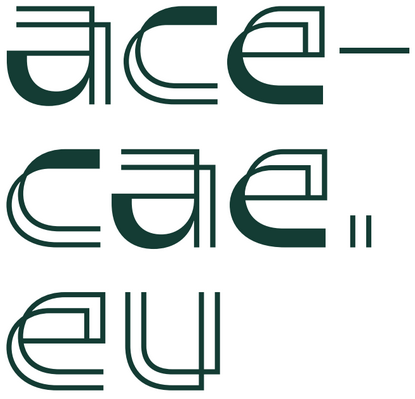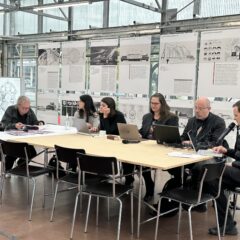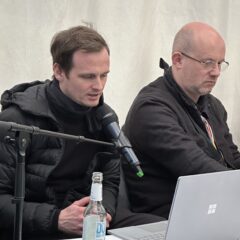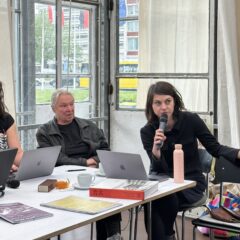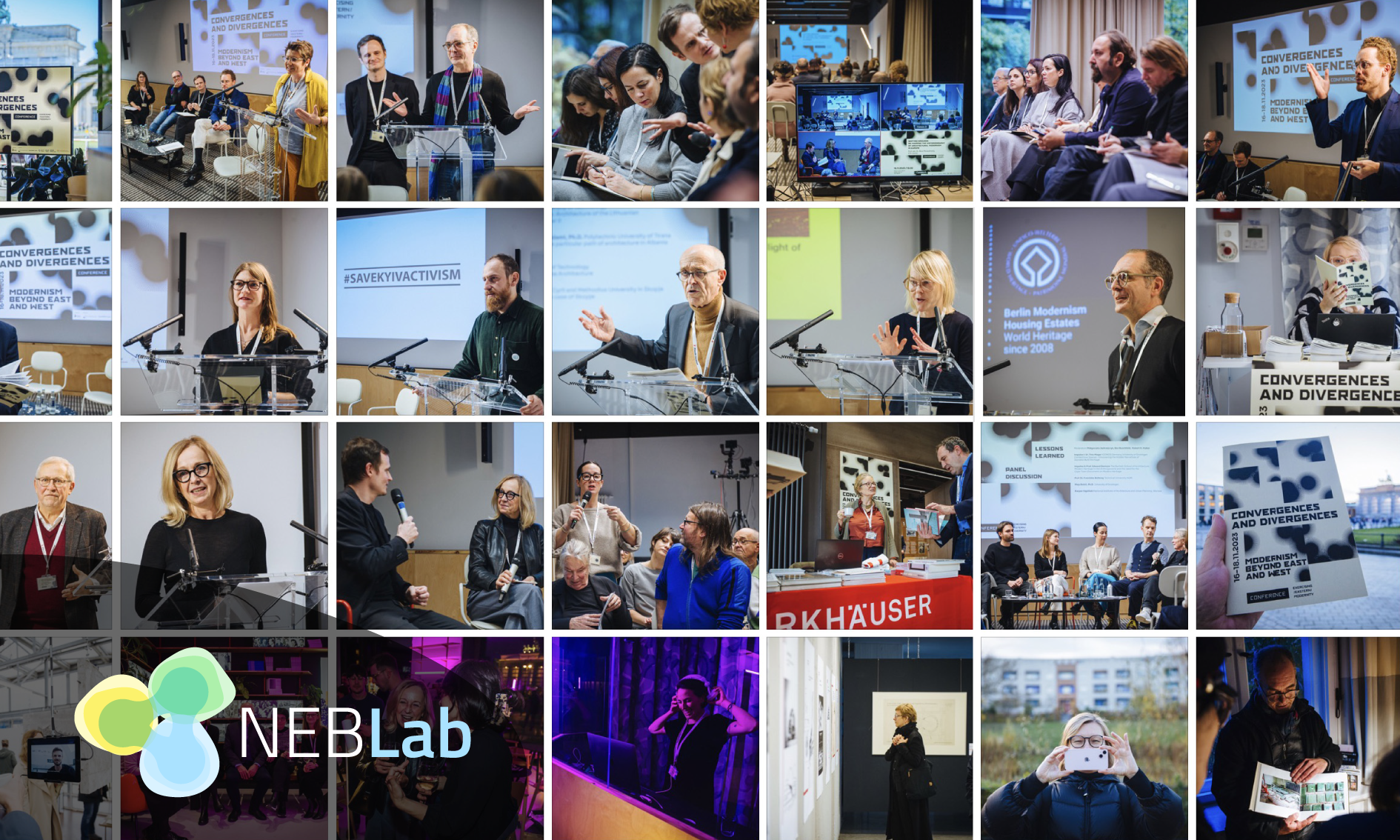
Conference “Convergences and Divergences“ – ETOM and Pilecki-Institute, Berlin © ETOM, buschfeld.com, 2023
Neues Lab im «New European Bauhaus» für «ETOM – European Triennial of Modernism» und am BHROX in Berlin
2024: Start für das «ETOM NEB Lab» als offizielles Lab im «New European Bauhaus» und erstes NEB-Projekt zum Thema des transeuropäischen Erbes der Moderne und der Resilienz moderner Ideen und Werte
ETOM Coordinators Meeting in BHROX bauhaus reuse © Photos: zukunftsgeraeusche, 2024
Das neue «ETOM NEB Lab» wurde initiiert von BHROX bauhaus reuse – als NEB-Partner und physisches Hub für das Lab in Berlin – zusammen mit den NEB-Partner*innen The Hungarian Contemporary Architecture Center (KEK), ICOMOS international, National Gallery Prague (NGP), Slovak Design Center (SDC), Estonian Academy of Arts (EKA) und Architects’ Council of Europe (ACE).
Das weiter wachsende «ETOM NEB Lab» dient als ein Co-Creation-Lab zur Entwicklung und Umsetzung von transnationaler Zusammenarbeit, Best Practice, Forschung und Capacity-Building. Das Lab baut auf einem Dreijahresrhythmus auf, um transdisziplinäre Kooperationsprojekte zu starten und zu verstetigen sowie alle drei Jahre die «European Triennial of Modernism» (ETOM) als dezentrales und wiederkehrendes Festival zur Baukultur der Moderne zu veranstalten.
Die Lab- und ETOM-Partner*innen umfassen bereits rund 10 offizielle NEB-Community-Partners und 30 weitere Partner*innen aus 15 Ländern mit heterogenem und sektorübergreifendem Hintergrund, wobei der Schwerpunkt zunächst auf Mitteleuropa liegt.
Das Motto des Labs und von ETOM ist «Diverse Modernism | Modern Diversity» und verkörpert einen integrativen Ansatz, der sich mit dem transeuropäischen Erbe, globalen und zukünftigen Perspektiven der Moderne und der Vielfalt der Protagonist*innen und heute beteiligten Akteur*innen, Hintergründe und Repräsentationen befasst. Das Lab beschäftigt sich mit dem gebauten Erbe der Moderne und der Geschichte moderner Ideen, deren transnationaler Genese und zeitgenössischen Ansätzen sowie der Nachhaltigkeit und Widerstandsfähigkeit moderner Werte, wie gesellschaftliche Emanzipation, soziale Gleichheit und demokratische Teilhabe und ihre Relevanz für zeitgenössische Herausforderungen.
Gemeinsame Themen und Herausforderungen
Auf der Grundlage der Arbeiten und Bedürfnisse, die von den Projektpartner*innen geäußert wurden, wurden sieben Cluster gemeinsamer Herausforderungen und Chancen für die Moderne in Europa identifiziert, um gemeinsam die folgenden Ziele für eine nachhaltigere Zukunft zu erreichen:
- Vielfältige transeuropäische Moderne: Förderung und Qualifizierung von Dialog, Forschung und Sichtbarkeit
- Die Moderne in Mitteleuropa von der Früh- bis zur Spätmoderne – und der Fall des Brutalismus: Entschlüsselung der fehlenden Verbindungen zwischen Ost und West
- Wertschätzung und Fortführung: Förderung eines nachhaltigen zeitgenössischen Kulturerbes und eines intelligenten und langsamen Tourismus
- Gefährdetes Kulturerbe – verlorene Daten, verlorene Gebäude: Strategien zur Erfassung, Freischaltung, zum Schutz und zur Zugänglichkeit entwickeln und pflegen
- Modernes Wohnen – bewohntes Erbe: Stabilisierung und Erhaltung von Substanz und sozialen Strukturen
- Moderne Wiederverwendung – fließendes Erbe: innovative alternative Strategien und Praktiken zur Entwicklung und zum Schutz
- Modernes Design: Erfassen und Erforschen von öffentlichem Design und Co-Design-Innovation zwischen Ost und West
Das Projekt fördert die Einbindung der Öffentlichkeit sowie zivilgesellschaftlicher und professioneller Interessengruppen auf lokaler und transnationaler Ebene und ist offen für die sektorübergreifende Beteiligung themenbezogener Organisationen mit zivilgesellschaftlichem, professionellem und staatlichem Hintergrund. Über die transnationale Zusammenarbeit hinaus wird das Projekt das Wachstum lokaler Netzwerke (lokale Lab-Chapter) rund um die Projektpartner unterstützen – mit besonderem Schwerpunkt in Mittel- und Osteuropa.
Ziele und Aufgaben
Im Allgemeinen werden mit den Projektaktivitäten Ziele in den folgenden vier voneinander abhängigen Bereichen verfolgt:
- Forschung: Um Herausforderungen und innovative Lösungen zu untersuchen, holt das Lab Beiträge verschiedener Akteur*innen ein, um Bedürfnisse, Erfahrungen und Wissen zu erkunden.
- Dialog: Um Themen nachhaltig zu entwickeln, fördert das Lab den öffentlichen Dialog, um Beteiligung zu ermöglichen und aufrechtzuerhalten, in verschiedenen Formaten bei regelmäßigen Treffen, Begegnungen, jährlichen Partnerveranstaltungen und dem alle drei Jahre stattfindenden Festival
- Co-Creation: für die Co-Creation von Projekten – mit Fokus auf die allgemeinen ETOM-Ziele oder bestimmte themenbezogene “Meilenstein”-Projekte – unterstützt das Projekt in hohem Maße die Teilnahme an allen Phasen der Co-Creation (5Cs): Co-Learning, Co-Design, Co-Production, Co-Präsentation, Co-Evaluation
- Kapazität: Um langfristige Erfolge beim Kapazitätsaufbau zu erzielen, fördert das Projekt Strukturen der sektorübergreifenden Zusammenarbeit auf transnationaler Ebene sowie die Einrichtung lokaler Netzwerke (d. h. lokaler Abteilungen um die Lab-Partner), die über die formellen NEB-Mitglieder hinaus verbreitet und ausgetauscht werden sollen.
Wie können Mitglieder der NEB-Gemeinschaft und andere Organisationen an dem Projekt teilnehmen?
Mitglieder der NEB-Gemeinschaft, Freunde und andere Organisationen können dies tun:
1. teilnehmen und beitragen
- Teilnahme an Veranstaltungen (öffentliche Konferenzen, Workshops)
- Teilnehmer*innen für Projekte und Veranstaltungen vorschlagen
- zur Forschung beizutragen (durch Kontaktaufnahme mit einem der LAB-Partner*innen)
2. sich für ein Amt im Beirat bewerben
3. sich als als LAB-PARTNER bewerben
- an den offiziellen Laborsitzungen und der Generalversammlung teilnehmen
- Beitrag zur Forschung auf nationaler Ebene und zur transnationalen Forschungsplattform
- gemeinsame Projekte vorschlagen und initiieren/teilnehmen
Ergebnisse (erste Agenda 2023-2025)
- Bildung thematischer Untergruppen – zu gemeinsamen Herausforderungen (7): Zusammenarbeit zu bestimmten Themen, Ermöglichung der gemeinsamen Entwicklung von Projekten (#dialogue #co-creation)
- Festlegung des Rahmens für eine transnationale Plattform für Forschung und bewährte Verfahren (1): Ermittlung der nationalen Ebenen und des Umfangs, Schaffung von Besonderheiten und eines Rahmens für eine gemeinsame Plattform (#Forschung #Kapazität)
- Initiierung der gemeinsamen Schaffung von Projekten (3+6): Zielnummer 3 für 2024 und 6 für 2025 (#co-creation)
- Wissenstransfer und Kapazitäten (2+4): jährliche Generalversammlung 2024 und 2025 (im Rahmen der jährlichen Konferenz) und Wissenstransfer-Workshops (2 pro Jahr), um vorhandenes Wissen zu bündeln, Erfahrungen und Ergebnisse auszutauschen, Zusammenarbeit zu initiieren und zu pflegen (#Forschung #Dialog #Ko-Kreation #Kapazität)
Vorläufige Etappenziele
Dezember 2023:
- Start des ETOM-NEB-Labs
- Beginn eines wiederkehrenden zirkulären 3-Jahres-ETOM-Ökosystems (#Co-Creation #Capacity)
2024
- Netzwerk von ETOM-NEB-Lab-Partnern ausbauen
- Einleitung des laufenden ETOM-Kapazitätsaufbauprozesses (#capacity)
- Ermittlung von Finanzierungsmöglichkeiten und Beantragung von Finanzmitteln (EU-Finanzhilfen) (#Ko-Bildung #Kapazitäten)
- Bildung thematischer Untergruppen zu gemeinsamen Herausforderungen (#Dialog #Ko-Kreation)
- Festlegung des Rahmens für eine transnationale Plattform für Forschung und bewährte Verfahren (#Forschung #Kapazität)
- Initiierung eines 3-jährigen, wiederkehrenden ETOM-Ko-Kreationsprozesses, der zu Projektvorschlägen führt (#Ko-Kreation)
- gemeinsames Lernen und Lancierung gemeinsamer transeuropäischer Projekte (Ziel Nr. 3) (#co-creation)
- Beginn der Koproduktion gemeinsamer transeuropäischer Projekte, um für das ETOM2025-Festival bereit zu sein (#co-creation)
- Durchführung von 2 Workshops für Wissenstransfer und Kapazitäten (#dialogue #capacity)
- Jährliche Konferenz, als synergetische Meilenstein-Veranstaltung (#Forschung #Dialog #Ko-Kreation #Kapazität)
2025
- Durchführung gemeinsamer transeuropäischer Projekte (Zielnummer 3+6) (#Ko-Kreation)Durchführung von 2 Workshops für Wissenstransfer und Kapazitäten (#Dialog #Kapazität)
- Co-Realisierung von transeuropäischen Projekten und Co-Präsentation bei der ersten Ausgabe des ETOM-Festivals im Jahr 2025 (#co-creation)
- jährliche Konferenz, mit ETOM-Festival (#Forschung #Dialog #Ko-Kreation #Kapazität)
2026
- Neustart der nächsten Generation von wiederkehrenden Kreislaufsystemen 3 Jahre Ökosystem
- Ko-Evaluierung gemeinsamer Projekte und ETOM2025-Festival
- Ko-Lernen der nächsten Generation und Start von transeuropäischen Gemeinschaftsprojekten der nächsten Generation
2027
- die nächste Generation der Koproduktion von transeuropäischen Projekten, die für das ETOM2028-Festival bereit sein soll
2028
- Ko-Realisierung transeuropäischer Projekte der nächsten Generation und Ko-Präsentation für das zweite ETOM-Festival 2028
2029
- Neustart der nächsten Generation von wiederkehrenden Kreislaufsystemen 3 Jahre Ökosystem
Koordinatoren und Mitwirkende
Alle ETOM-NEB-LAB-Koordinatoren sind Mitglieder der NEB-Gemeinschaft. Zur Gruppe der Koordinatoren gehören:
- BHROX bauhaus reuse / zukunftsgeraeusche – Germany | Berlin
- KÉK – The Hungarian Contemporary Architecture Centre – Hungary | Budapest
- ICOMOS international – International | France | Paris
- NGP – National Gallery Prague – Czech Republic | Prague
- SDC – Slovak Design Center – Slovakia | Bratislava
- EKA – Estonian Academy of Arts – Estonia | Tallinn
- ACE – Architects’ Council of Europe – Belgium | Brussels
An der Gründung und Durchführung des Projekts sind auch die folgenden Organisationen beteiligt:
Estland | Tallinn
- Estonian Museum of Architecture
- City of Tallinn
Lettland | Riga
- Latvian National Museum
- Latvian Ministry of Culture
Litauen | Kaunas
- Kaunas 2022
- Architects Association of Lithuania (NEB Partner)
- Nematerialaus Turto Fondas / Ekskursas festival
- Kaunas City Municipal Administration
Polen | Warschau / Krakau
- National Institute of Architecture and Urban Planning
- Institute of Architecture Foundation
- City Council of Krakow
Deutschland | Berlin
- Architektenkammer Berlin (NEB partner)
- buschfeld.com – graphic and interface design
- Landesdenkmalamt Berlin
- Kunstbibliothek Berlin – Staatliche Museen zu Berlin / Stiftung Preußischer Kulturbesitz
- Goethe-Institut (NEB-partner)
Tschechische Republik | Prag / Brünn
- District Praha 7
- 4AM, Brno
- House of Arts, Brno
Ukraine | Lviv / Kharkiv
- Centre for Urban History, Lviv
- Lviv Polytechnic University
- Urban Forms Center, Kharkiv
Ungarn | Budapest
- Hungarian Museum of Architecture & Monuments Protection Documentation Center
- Budapest 13th District / Budapest Municipality
Rumänien | Bucharest
- ARCEN
- Zeppelin magazine / SG STUDIO
- Second District Hall of Bucharest
Serbien | Belgrad
- BINA – Belgrade International Architecture Week / Association of Belgrade Architects
- Cultural Heritage Preservation Institute of Belgrade
- Municipality of New Belgrade
Nordmazedonien | Skopje
- Contineo 2020
- School of Architecture and Design – University American College
International | Niederlande | Delft
International | Belgien | Brüssel
- Architect Council of Europe (NEB Partner)
Lab location & hub in Berlin
BHROX bauhaus reuse
Ernst-Reuter-Platz, Mittelinsel, D – 10587 Berlin
www.bauhaus-reuse.de
ETOM
Web: www.triennale-der-moderne.de/2022/european-triennial-of-modernism-etom/
Instagram: @triennale_der_moderne
Facebook: TriennaleDerModerne
Twitter / X: TdModerne
Lab Kontakt
Robert K. Huber (BHROX bauhaus reuse / zukunftsgeraeusche)
Eszter Davida (KEK – Hungarian Contemporary Architecture Center)
www.new-european-bauhaus.europa.eu
Alle Anfragen und Presse-Kontakt: info@bauhaus-reuse.de
Ansprechpartnerin: Adelina Nicolaescu (BHROX)





